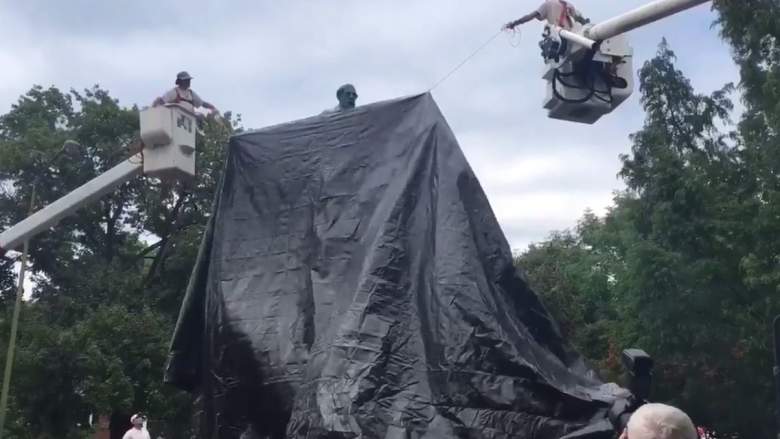
Confederate statues in Charlottesville, Virginia were covered by black tarps on Tuesday.
Less than two weeks after the city was overrun with violence spurred by a white nationalist rally, the city of Charlottesville covered two statues of Confederate general with black tarps.
The city council voted unanimously Monday to cover two Confederate statues standing in the city with black fabric. On Wednesday, government workers were seen at the site of the controversial Robert E. Lee and Thomas “Stonewall” Jackson statues, using cranes to put a black tarp over the monuments.
Daily Progress reporter Lauren Berg was on scene to witness the statues being draped by the tarp and tweeted out a few photos and videos to show the process.
The decision to cover the statues with the fabric came at a city council meeting that saw massive tensions and erupted with protests. The protests continued to escalate throughout the meeting and police removed three people, who were charged with disorderly conduct, as a result.
On August 12, hundreds of counter-protesters rallied in the streets of Charlottesville to demonstrate against the “Unite the Right” rally, which brought hate groups donned in Nazi flags to the city. Participants of the “Unite the Right” rally flocked to the city to protest a proposal that would have removed the General Lee statue from the city park. Those demonstrators marched throughout the city with lit torches shouting racist statements and making Nazi-like salutes August 11.
Less than 10 hours after the torch-lit rally, a group of counter-protesters were interrupted by a man, James Alex Fields Jr., who allegedly drove down the crowded street with a vehicle, striking and killing a woman, 32-year-old Heather Heyer, and injuring 19 more.
In the days that followed, President Donald Trump weighed in on his thoughts of the incident. At first, he condemned the groups responsible, calling out the Ku Klux Klan and neo-Nazis by name. But the next day during a press conference, Trump seemed to take back what he said the day before. The president said that “both sides” were to blame for the violence in Charlottesville, noting the “alt-left” counter-protesters and the hate groups.
Trump also said at the press conference that the act of removing Confederate statues from cities is “changing history” and American culture. He compared the removal of the statues to taking down monuments dedicated to George Washington and Thomas Jefferson.
There are over 1,500 symbols of Confederation across the nation, and many cities have been proactive in removing or altering them. The events of the Charlottesville rally have increased the rate at which the symbols are being taken down across the nation, the Chicago Tribune reported.
Two statues were taken down immediately in Gainesville, Florida, while calls for widespread removals have been made in numerous states across the nation.
In Maryland, Republican Governor Larry Hogan said he intended to push for the removal of a statue of former Supreme Court Chief Justice Roger Taney, whose ruling affirmed slavery.
“While we cannot hide from our history, nor should we, the time has come to make clear the difference between properly acknowledging our past and glorifying the darkest chapters of our history,” Hogan, who at first resisted calls for its removal, said.
Many of the Confederate monuments across the nation sit on government grounds at buildings such as state capitols or court houses, while other examples include parks named after notable figures of the Civil War or other expressions. Some of the symbols are listed on the National Register of Historic Places.
Dallas Mayor Mike Rawlings on August 15 asked his city staff to appoint a task force to study the fate of Confederate monuments in the Texas city.
In Tennessee, Republican Governor Bill Haslam called for the removal of a bust of Nathan Bedford Forrest, a Confederate general and former leader of the Ku Klux Klan. According to The Tribune, similar plans to remove symbols of the Confederacy have been made in Memphis, San Antonio, Baltimore and Lexington Kentucky.


